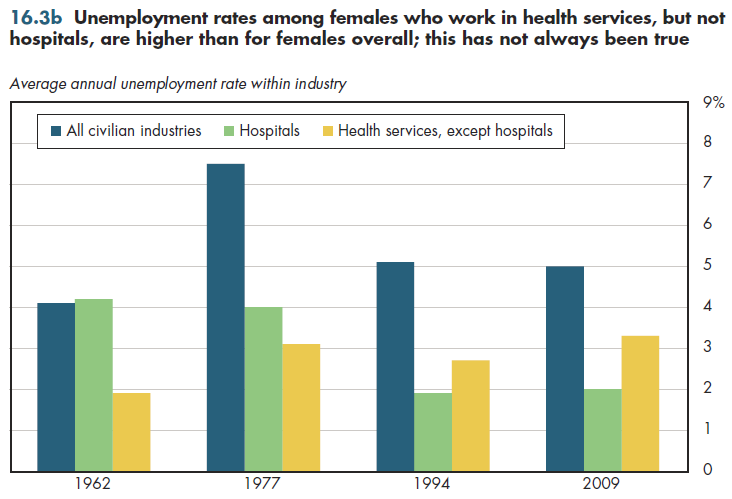Download PowerPoint versions of both figures.
Inside Collection (Textbook): Chapter 16: Economic Fluctuations and Health
16.3 Unemployment Rates for Male Workers in the Health Sector Are Lower than the Rest of the Economy
Summary: Unemployment rates for workers in the health sector are lower for males but not for females, compared with workers in the rest of the economy.
For almost 50 years, unemployment rates among males working in hospitals or other parts of the health services industry have been lower than for their counterparts in the rest of the economy (figure 16.3a). Since at least 1994, male unemployment rates in non-hospital health settings have been somewhat higher than for those working in hospitals. Before, the reverse was true. For these data, non-hospital health settings include nursing homes in addition to physician offices or other ambulatory settings. Note also that the unemployment rates shown are for experienced workers only, not for new workers or those reported as being "not in labor force" because of school, an inability to find work, or other reasons.

The picture for females is quite different. For female health services workers out- side of hospitals, the unemployment rate has routinely been higher than for females elsewhere in the economy—typically by two to three percentage points (figure 16.3b). For female hospital workers, the pattern is the same as just described for males. Since at least 1994, female hospital workers have had a somewhat lower unemployment rate than have all females. In the limited data from the 1960s and 1970s, the reverse was true, with female unemployment among hospital workers being one to two percentage points higher than the rate for women generally.

Both worker hours and employment have been increasing in the hospital sector in recent years (refer to figure 10.1b). This indicates the strong demand for hospital labor, which is reflected in their lower unemployment rate. The reason is less clear as to why the pattern for women has diverged so significantly from that of men. In all periods, women have a lower general unemployment rate than men. However, unemployment in non-hospital health services is routinely higher for women than for men in all of the annual data. Within the hospital industry, female unemployment rates were somewhat higher than were men's decades ago. More recently, female unemployment rates have been less than male unemployment rates by approximately 1 percent. Why women now have attained a margin of advantage over men in the hospital sector but not in the rest of the health services industry is not well understood.
Downloads
References
- Author's calculations.
- Department of Commerce. Bureau of the Census.
Collection Navigation
- « Previous module in collection 16.2 Medicaid Spending Tends to Be More Countercyclincal among Components of NHE
- Collection home: Chapter 16: Economic Fluctuations and Health
Content actions
Give feedback:
Download:
Add:
Reuse / Edit:
Twin Cities Campus:
- © 2012 Regents of the University of Minnesota. All rights reserved.
- The University of Minnesota is an equal opportunity educator and employer. Privacy
- Last modified on Sep 25, 2013 2:17 pm -0500








